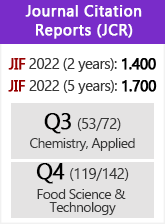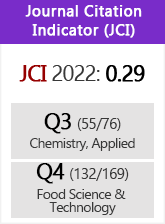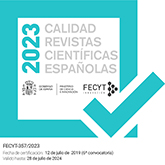Antioxidant and antimicrobial properties of kaff maryam (Anastatica hierochuntica) and doum palm (Hyphaene thebaica)
DOI:
https://doi.org/10.3989/gya.064509Keywords:
Antimicrobial activity, DPPH assay- Lycopene, Phenolic compounds, Radical scavenger activityAbstract
The widespread use of medicinal plants for health purposes has increased dramatically due to their great importance to public health. In this study, the levels of phenolic, flavonoid, β-carotene and lycopene compounds of Anastatica hierochuntica and Hyphaene thebaica were determined. The plant extracts were evaluated for their antioxidant activities using various antioxidant methodologies: (i) scavenging of free radicals using 2, 2-diphenyl-1-picrylhydrazyl, (ii) metal ion chelating capacity, and (iii) scavenging of superoxide anion radical. The antimicrobial activity of both plant extracts was evaluated against a panel of microorganisms using the agar disc diffusion method. The total phenolic content (51.97 and 64.9 mg/g dry weight in A. hierochuntica and H. thebaica, respectively) was significantly (p < 0.05) different. The antioxidant activity increased with an increase in concentration. The plant extracts were more active against Gram-positive bacteria than Gram-negative bacteria. Also, the antimicrobial activity of H. thebaica was higher than that of A. hierochuntica methanolic extracts. This study reveals that the consumption of these plants would exert several beneficial effects by virtue of their antioxidant and antimicrobial activities.
Downloads
References
Anonymous A. 1989. Cohort Software Corp. Costate user manual version 3.03, Barkley CA, USA. Asuzu IU. 1986. Pharmacological evaluation of folklore of Sphenostylic Slenocarpa. Journal Ethanopharmacol 16, 236-267.
Austin DJ, Kristinsson KG, Anderson RM. 1999. The relationship between the volume of antimicrobial consumption in human communities and the frequency of resistance. Proceedings of the National Academy of Sciences USA 96, 1152-1156. doi:10.1073/pnas.96.3.1152
Barlow SM. 1990. Toxicological Aspects of Antioxidants Used as Food Additives. In Food Antioxidants, Hudson BJF (Ed.), Elsevier, Amsterdam, pp. 23.
Bauer AW, Kirby WMM, Sherris JC, Truck M. 1966. Antibiotic susceptibility testing by a standardized single disc method. American Journal of Clinical Pathology 45, 493-496. PMid:5325707
Blois MS. 2002. Antioxidant determinations by the use of a stable free radical. Nature 26, 1199-1200.
Cowan MM. 1999. Plants products as antimicrobial agents. Clinical Microbiology Reviews 12, 564-582. PMid:10515903 PMCid:88925 Das NP, Pereira TA. 1990. Effects of flavonoids on thermal autooxidation of Palm oil: structure- activity relationship. Journal of American Oil Chemists Society 67, 255-258. doi:10.1007/BF02540652
Deighton N, Brennan R, Finn C, Davies HV. 2000. Antioxidant properties of domesticated and wild Rubus species. Journal of the Science of Food and Agriculture 80, 1307-1313. doi:10.1002/1097-0010(200007)80:9<1307::AID-JSFA638>3.0.CO;2-P
Dinis TCP, Madeira VMC, Almeida LM. 1994. Action of phenolic derivatives (acetaminophen, salicylate, and 5-aminosalicylate) as inhibitors of membrane lipid peroxidation and as peroxyl radical scavengers. Archives of Biochemistry and Biophysics 315, 161-169. doi:10.1006/abbi.1994.1485 PMid:7979394
Dosumu OO, Nwosu FO, Nwogu CJ. 2006. Phytochemical screening and anti-microbial studies of extracts of Hyphaene thebaica linn (Mart) Palmae. International Journal of Tropical Medicine 1(4), 186-189.
Duh PD, Tu YY, Yen GC. 1999. Antioxidant activity of water extract of harng jyur (Chrysanthemum morifolium Ramat). Lebensm Wiss Technol 32, 269-277. doi:10.1006/fstl.1999.0548
Exarchou V, Nenadis N, Tsimidou M, Gerothanassis IP, Troganis A, Boskou D. 2002. Antioxidant activities and phenolic composition of extracts from Greek oregano, Greek sage and summer savory. Journal of Agricultural and Food Chemistry 50 (19), 5294-5299. doi:10.1021/jf020408a PMid:12207464
Halliwell B, Gutteridge JMC. 1985. In Free radicals, ageing, and disease, free radicals in biology and medicine, 2nd ed, Oxford, Clarendron Press, pp. 279-315.
Halliwell B. 1991. Reactive oxygen species in living systems: source, biochemistry and role in human disease. American Journal of Medicine 91, 14-22. doi:10.1016/0002-9343(91)90279-7
Halliwell B, Aeschbach R, Loliger J, Aruoma OI. 1995. The characterization of antioxidants. Food Chemistry and Toxicology 33(7), 601-617. doi:10.1016/0278-6915(95)00024-V
Havsteen BH. 2002. The biochemistry and medical significance of the flavonoids. Pharmacology and Therapeutics 96, 67-202. doi:10.1016/S0163-7258(02)00298-X
Hsu B, Coupar IM, Ng K. 2006. Antioxidant activity of hot water extract from the fruit of the Doum palm, Hyphaene thebaica. Food Chemistry 98, 317-328. doi:10.1016/j.foodchem.2005.05.077
Irobi ON, Adedayo O. 1999. Antifungal activity of aqueous extract of dormant fruits of Hyphaene thebaica (Palmae). Pharmacological-Biology 37(2), 114-117. doi:10.1076/phbi.37.2.114.6083
Jia Q, Hong MF, Minter D P. 1999. A novel iridoid from Picrorhiza kurroa. Journal of Natural Product 62, 901-903. doi:10.1021/np980493+ PMid:10395515
Kamis AB, Modu S, Zanna H, Oniyangi TA. 2003. Preliminary biochemical and haematological effects of aqueous suspension of pulp of hyphaene thebaica (l) mart in rats. Biokemistri 13, 1-7.
Kessler M, Ubeaud G, Jung L. 2003. Anti- and prooxidant activity of rutin and quercetin derivatives. Journal of Pharmacy and Pharmacology 55, 131-142. doi:10.1211/002235702559 PMid:12625877
Lloyd RV, Hanna PM, Mason RP. 1997. The origin of the hydroxyl radical oxygen in the Fenton reaction. Free Radical Biology and Medicine 22(5), 885-888. doi:10.1016/S0891-5849(96)00432-7
Matkowski A, Piotrowska M. 2006. Antioxidant and free radical scavenging activities of some medicinal plants from the Lamiaceae. Fitoterapia 77(5), 346-353. doi:10.1016/j.fitote.2006.04.004 PMid:16713687
Moniharapon E, Hashinaga F. 2004. Antimicrobial activity of Atung (parinarium glaberrimum Hassk) fruit extract. Pakistan Journal of Biological Science 7(6), 1057-1061. doi:10.3923/pjbs.2004.1057.1061
Mortensen A, Skkibsted LH. 1997. Importance of carotenoid structure in radical-scavenging. Journal of Agricultural and Food Chemistry 45, 2970-2977. doi:10.1021/jf970010s
Nagata M, Yamashita I. 1992. Simple method for simultaneous determination of chlorophyll and carotenoids in tomato fruit. Nippon Shokuhin Kogyo Gakkaish 39(10), 925-928.
Nishimiki M, Rao NA, Yagi K. 1972. The occurrence of superoxide anion in the reaction of reduced phenazine methosulfate and molecular oxygen. Biochemical and Biophysical Research Communication 46, 849-853. doi:10.1016/S0006-291X(72)80218-3
Oyaizu M, Fujimoto Y, Ogihara H, Sekimoto K, Naruse A, Naruse U. 2003. Antioxidative and antimicrobial activities extracts from several utility plants. Food Preservation Science 29, 33-38.
Parekh J, Nair R, Chanda S. 2005. Preliminary screening of some folkloric plants from Western India for potential antimicrobial activity. Indian Journal of Pharmacology 37, 408-409. doi:10.4103/0253-7613.19085
Rizk AM, El Ghazaly GA. 1995. Medicinal and Poisonous Plants of Qatar, Kingprint of Richmond on behalf of Scientific and Applied Research Centre, University of Qatar, 140-144.
Sharaf A, Sorour A, Gomaa N, Youssef M. 1972. Some pharmacological studies on Hyphaene thebaica. Qualitas Plantarium Materiae Vegetables 22(1), 83-90. doi:10.1007/BF01099739
Shariff ZU. 2001. Modern Herbal Therapy for Common Ailments. Nature Pharmacy Series Vol.1, Spectrum Books Ltd., Ibadan, Nigeria in Association with Safari Books (Export) Ltd. UK, pp. 9-84.
Shimada K, Fujikawa K, Yahara K, Nakamura T. 1992. Antioxidative properties of xanthone on the auto oxidation of soybean in cylcodextrin emulsion. Journal of Agricultural and Food Chemistry 40, 945-948. doi:10.1021/jf00018a005
Simonne AH, Kays SJ, Koehler PE, Eitenmiller RR. 1993. Assessment of β-carotene content in sweet potato breeding lines in relation to dietary requirements. Journal of Food Composition and Analysis 6, 336-345. doi:10.1006/jfca.1993.1037
Singleton VL, Orthofer R, Lamuela-Raventos RM. 1999. Analysis of total phenols and other oxidation substrates and antioxidants by means of Folin-Ciocalteu reagent. Methods in Enzymology 299, 152-178. doi:10.1016/S0076-6879(99)99017-1
Soares JR, Dinis TCP, Cunha AP, Almeida LM. 1997. Antioxidant activities of some extracts of Thymus zygis. Free Radical Research 26, 469-478. doi:10.3109/10715769709084484
Soong YY, Barlow PJ. 2004. Antioxidant activity and phenolic of selected fruit seeds. Food Chemistry 88, 411-417. doi:10.1016/j.foodchem.2004.02.003
Surh YZ, Ferguson LR. 2003. Dietary and medicinal antimutagens and anticarcinogens: molecular mechanisms and chemopreventive potential-highlight of a symposium.
Tanaka M, Kuei CW, Nagashima Y, Taguchi T. 1998. Application of antioxidative millard reaction products from histidine and glucose to sardine products. Nippon Suisan Gakkaishil 54, 1409-1414.
Vaya J, Belinky PA, Aviram M. 1997. Antioxidant constituents from licorice roots: Isolation, structure elucidation and antioxidative capacity toward LDL oxidation. Free Radical Biology and Medicine 23(2), 302-313. doi:10.1016/S0891-5849(97)00089-0
Yanishlieva-Maslarova NV. 2001. Inhibiting oxidation. In: Antioxidants in Food Practical Applications. J. Pokorny, N. Yanishlieva and M. Gordon (Ed.), Woodhead Publishing Ltd, Cambridge, pp. 22-70.
Yokozawa T, Chen CP, Dong E, Tanaka T, Nonaka GI, Nishioka I. 1998. Study on the inhibitory effect of tannins and flavonoids against the 1,1-Diphenyl-2-picrylhydrazyl radical. Biochemical Pharmacology 56, 213-222. doi:10.1016/S0006-2952(98)00128-2
Yoshikawa M, Xu F, Morikawa T, Ninomiya K, Matsuda H. 2003. Anastatins A and B. New skeletal flavonoids with hepatoprotective activities from the desert plant Anastatica hierochuntica. Bioorganic & Medicinal Chemistry Letters 13(6), 1045-1049. doi:10.1016/S0960-894X(03)00088-X
Downloads
Published
How to Cite
Issue
Section
License
Copyright (c) 2010 Consejo Superior de Investigaciones Científicas (CSIC)

This work is licensed under a Creative Commons Attribution 4.0 International License.
© CSIC. Manuscripts published in both the printed and online versions of this Journal are the property of Consejo Superior de Investigaciones Científicas, and quoting this source is a requirement for any partial or full reproduction.All contents of this electronic edition, except where otherwise noted, are distributed under a “Creative Commons Attribution 4.0 International” (CC BY 4.0) License. You may read here the basic information and the legal text of the license. The indication of the CC BY 4.0 License must be expressly stated in this way when necessary.
Self-archiving in repositories, personal webpages or similar, of any version other than the published by the Editor, is not allowed.
















